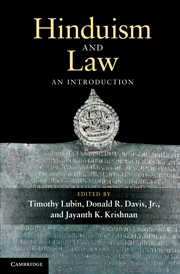Book contents
- Frontmatter
- Contents
- List of contributors
- Acknowledgements
- Chronology
- Abbreviations
- Map South Asia: political divisions c. 1860 and today
- Introduction
- Part I Hindu law
- Part II Law in ancient and medieval Hindu traditions
- Part III Law and modern Hinduism
- Chapter 12 Temples, deities, and the law
- Chapter 13 In the divine court of appeals
- Chapter 14 Contemporary caste discrimination and affirmative action
- Chapter 15 Law and Hindu nationalist movements
- Chapter 16 Legally and politically layered identities
- Glossary
- Bibliography
- Index
Chapter 13 - In the divine court of appeals
vows before the god of justice
Published online by Cambridge University Press: 05 June 2012
- Frontmatter
- Contents
- List of contributors
- Acknowledgements
- Chronology
- Abbreviations
- Map South Asia: political divisions c. 1860 and today
- Introduction
- Part I Hindu law
- Part II Law in ancient and medieval Hindu traditions
- Part III Law and modern Hinduism
- Chapter 12 Temples, deities, and the law
- Chapter 13 In the divine court of appeals
- Chapter 14 Contemporary caste discrimination and affirmative action
- Chapter 15 Law and Hindu nationalist movements
- Chapter 16 Legally and politically layered identities
- Glossary
- Bibliography
- Index
Summary
This chapter discusses the place of law and justice within the context of “folk” Hinduism by referring to the practice of social justice from the perspective of the religious cult of Goludev, a widely venerated regional, “folk” deity in the recently formed central Himalayan state of Uttarakhand. While the nature and content of “Hindu law” has been discussed at relative length from the perspective of classical textual sources as well as on the basis of evidence provided by inscriptions, scant attention has been paid to the conceptual understanding and actual practice of law in non-classical, contemporary “folk” traditions within the broader framework of Hinduism. Thus, for example, what does it mean to imagine temples as legal courts in which the deity receives legal (and other) petitions? In what ways do rituals of divine embodiment (or “possession”) enact and articulate concepts of social justice?
Goludev presides explicitly over matters of justice (nyāy) and is known in the Himalayan district of Kumaon as the “god of justice” (nyāy kā devtā). Kumaon is a mountainous region bordering on Nepal in the east and Tibet in the north. Together with Garhwal, a region that lies to its west, Kumaon forms the state of Uttarakhand. Goludev is worshiped by both high-ranked and low-ranked communities (Thakurs, Brahmans, Dalits). Goludev’s devotees perceive him to be a manifestation or incarnation of Bhairav, the wild and terrifying aspect of Śiva. In Kumaon, the juristic authority of Goludev is considered greater than the authority of civil courts in the region. In several instances, for example, if someone involved in a civil suit threatened to take a petition to Goludev, the party in the wrong would quickly back down and admit to being in the wrong rather than have Goludev deal with the “case.”
- Type
- Chapter
- Information
- Hinduism and LawAn Introduction, pp. 207 - 214Publisher: Cambridge University PressPrint publication year: 2010
- 2
- Cited by

